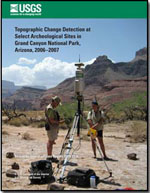Topographic change of archeological sites within the Colorado River corridor of Grand Canyon National Park (GCNP) is a subject of interest to National Park Service managers and other stakeholders in the Glen Canyon Dam Adaptive Management Program. Although long-term topographic change resulting from a variety of natural processes is typical in the Grand Canyon region, a continuing debate exists on whether and how controlled releases from Glen Canyon Dam, located immediately upstream of GCNP, are impacting rates of site erosion, artifact transport, and the preservation of archeological resources. Continued erosion of archeological sites threatens both the archeological resources and our future ability to study evidence of past cultural habitation. Understanding the causes and effects of archaeological site erosion requires a knowledge of several factors including the location and magnitude of the changes occurring in relation to archeological resources, the rate of the changes, and the relative contribution of several potential causes, including sediment depletion associated with managed flows from Glen Canyon Dam, site-specific weather patterns, visitor impacts, and long-term climate change. To obtain this information, highly accurate, spatially specific data are needed from sites undergoing change. Using terrestrial lidar data collection techniques and novel TIN- and GRID-based change-detection post-processing methods, we analyzed topographic data for nine archeological sites. The data were collected using three separate data collection efforts spanning 16 months (May 2006 to September 2007). Our results documented positive evidence of erosion, deposition, or both at six of the nine sites investigated during this time interval. In addition, we observed possible signs of change at two of the other sites. Erosion was concentrated in established gully drainages and averaged 12 cm to 17 cm in depth with maximum depths of 50 cm. Deposition was concentrated at specific locations outside of drainages but generally was spread over larger areas (tens to hundreds of square meters). Maximum depths of deposition averaged 12 cm to 15 cm and reached as much as 35 cm. Overall, we found that the spatial distribution and magnitudes of surface change are specific to each site and that a thorough understanding of the geomorphology, weather, and sand supply is requisite for a complete understanding of the data. Additional work in combining these results with site-specific weather, hydrology, and geomorphology data will assist in the development of working models for determining the causes of the documented topographic changes.


